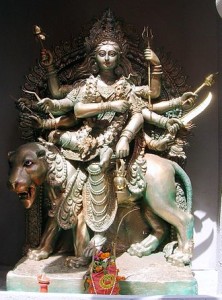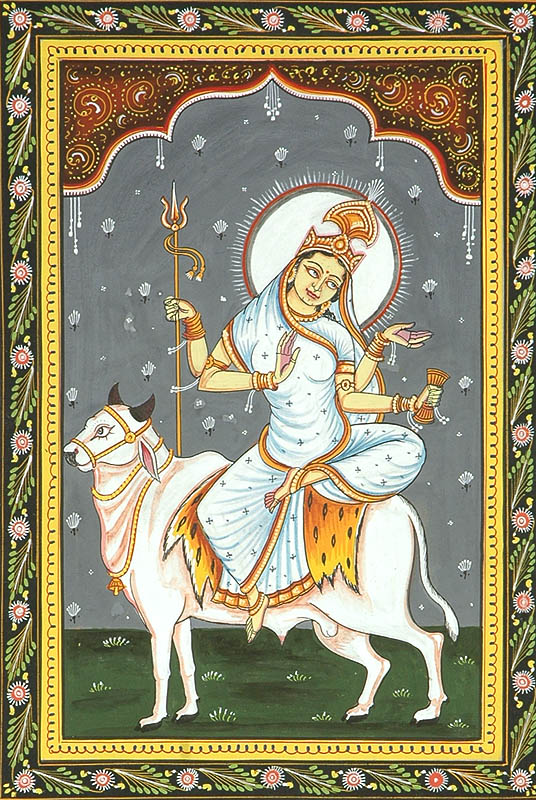
by Somya Devi | Apr 29, 2022 | Astrology, Conjunctions, Eclipses, Events, Holy Days, Planets Changing Signs
Eclipse Season, Venus-Jupiter Conjunction, and Akshaya Tritiya
There is so much going on in the sky right now, this is an exciting time for astronomers and astrologers alike. Tonight brings a Dark Moon as Sun and Moon approach each other for an exact New Moon conjunction on April 30th at 4:28 pm ET. They join in sidereal Aries, where Sun is exalted and Rahu is currently transiting as well. This meeting of Sun, Moon and Rahu stimulates a solar eclipse around the time of the New Moon, the first eclipse of this spring’s eclipse season, with the lunar eclipse following on the Full Moon of May 15th-16th. Additionally, Venus and Jupiter are having their closest conjunction of the year on April 30th as well!
Aries Moon Cycle
The Aries Moon cycle begins when Sun and Moon join in sidereal Aries. If you’ve forgotten the difference between sidereal and tropical systems, here it is! I just re-read this article and definitely recommend checking it out if this is a concept you strive to understand. The Sun is exalted as it travels through Aries, bringing forth a strong sense of vitality and energy as we emerge into the growing season in the northern hemisphere. The Aries cycle is a time for beginning and giving birth to things, just as we see reflected in nature.
Bharani Nakshatra
This Moon cycle begins literally with Sun and Moon in the Vedic nakshatra Bharani, “the bearer,” the star of birth and death. It is represented by a womb, associated with fertile Venus, ruled by death deity Yama, and opens a portal between the worlds of living and dying. This moon cycle is an opportune time to plant the seeds you are wishing to cultivate, both literally and figuratively.
Akshaya Tritiya
Three days after the New Moon in Aries, on Tuesday, May 3rd, the Moon travels through its sign of exaltation as well— Taurus. A sign of exaltation is the place where a planet is considered extremely well-placed, supported by the ruler of that sign, and in good relationship with its home sign. It’s where the planet is most likely to be able to express itself positively through us. With the Sun exalted in Aries, it is supported by its ruler Mars, a planet that adds courage and strength to Sun who seeks to express power and vitality. With the Moon exalted in Venus-ruled, earth-sign Taurus, it gets to rest on fertile and stable ground, an excellent place for our watery, emotional and often changeable mind to reside in the feminine.
With both Sun AND Moon exalted at the same time, this signals that our minds, bodies, and spirit are extremely well-supported. For this reason, this “tritiya” (third waxing Moon) day is thought to be a day that offers only auspicious, prosperous, everlasting results. Hence it is deemed Akshaya Tritiya, “akshaya” being that which is without loss, that which never diminishes. In India this is a major moment for investments, new beginnings, and large purchases, especially of gold and silver. It is thought that your returns will be “never diminishing.”
Although usually I like to offer specific Muhurta selections based on one’s individual natal chart, this day is generally considered auspicious in general for new endeavors, purchases, and investments.
Solar Eclipse
April 30th, the New Moon, itself brings with it a solar eclipse that will be visible from parts of South America and Antarctica. Its effects, however, can be felt across the globe. You may have already noticed tensions rising in your life this week, especially around certain areas where you have felt stuck. Eclipses are when the shadow energy becomes visible (we literally see a shadow when the grahas Rahu and Ketu align with Sun, Moon and Earth). They tend to bring to light areas that require our attention and change, whether it be by eliminating limiting beliefs or patterns, or by stepping into something we have resisted.
This is the first eclipse of a 1.5-year cycle that began when Rahu and Ketu transited into the Aries-Libra axis on April 12th, after their year-and-half transit of Taurus and Scorpio before that. This longer cycle and the biannual eclipse seasons within it are likely to “bring stuff up” for you in whatever areas of life are indicated by Aries and Libra in your Vedic natal chart, and may stimulate other karma depending upon what other planets are there in your chart.
As in many traditional cultures, in Vedic thought eclipses are considered inauspicious times, because the natural order of the universe is turned on its head. It is best not to plan any important activities or new beginnings during the hours of the eclipse itself (2:25 PM – 6:38 PM ET, with maximum eclipse at 4:42). Instead, spiritual practice such as prayer or meditation is advised, as these are the best remedies for dealing with the disruptive, confusing and often virulent energy of the nodes, Rahu and Ketu. Hindu culture advises against eating, drinking or being outside during the eclipse hours as well, especially if you live in its visible path.

This is the first eclipse of two that are coming this eclipse season, the second being a lunar eclipse on the Full Moon of May 15th-16th, which will be visible from most of the Americas, Europe, Africa and the Middle East. After that the eclipse season ends until the next set which will come in October-November of this year.
Some astrologers advise people to do things around an eclipse as these can be transformative times. They can definitely be transformative, but I always caution clients that if you are to make a major decision during an eclipse season, be sure that it comes from a place of clarity, after much reflection and introspection, and that it is not based out of stress, fear, or overwhelm with your current situation.
Jupiter-Venus Conjunction/War
In addition to the New Moon and Solar Eclipse, Saturday also brings the exact conjunction of Jupiter and Venus, at 5:14 pm ET in sidereal Pisces. The two will be traveling together in this sign from April 27th through May 23rd, when Venus moves into Aries. Jupiter is the ruler of Pisces, while Venus is exalted there, giving the two brightest planets a lot of power right now. It will be a beautiful sight to behold on the early mornings of April 30th and May 1st, while they can be seen extremely close together rising a little while before the Sun. (EarthSky has some great visuals on what to look for in the early morning eastern sky.)
The intense proximity of the two, however, creates what is known as a graha yuddha or planetary war in Vedic astrology. This happens whenever two planets come within one degree of each other, as these two do from April 29th through May 1st. When this happens, both planets are considered to be weakened because they must vie with each other for power and our attention. Thus the areas ruled by Jupiter (inspiration, hope, beliefs) and Venus (happiness, romance, art, beauty, nature) in general and in our personal charts, may suffer during this time.
The war between Jupiter and Venus can be particularly difficult as these two are quite inimical to each other, Jupiter being the guru of the Gods and Venus that of the Asuras (demons). Jupiter or Guru guides us to acquire our higher belief systems, knowledge, and wisdom, while Venus or Shukra motivates us mainly towards pleasure. It is for this reason that Venus becomes exalted in Pisces, because when under Jupiter’s influence, in this other-worldly water sign, we are often able to align our desires with a higher power or purpose.
So enjoy the spectacle of the two brightest planets this weekend, but consider the highest potential of the two as you feel the waves of emotion that may come as they battle it out, with the Moon and eclipsed Sun joining Rahu in fiery Aries. Overall I do believe this whole setup offers a lot of potential for inner growth, if we take the time to go inward and seek insight around our highest purpose, desires, and intentions for this season’s new beginnings.
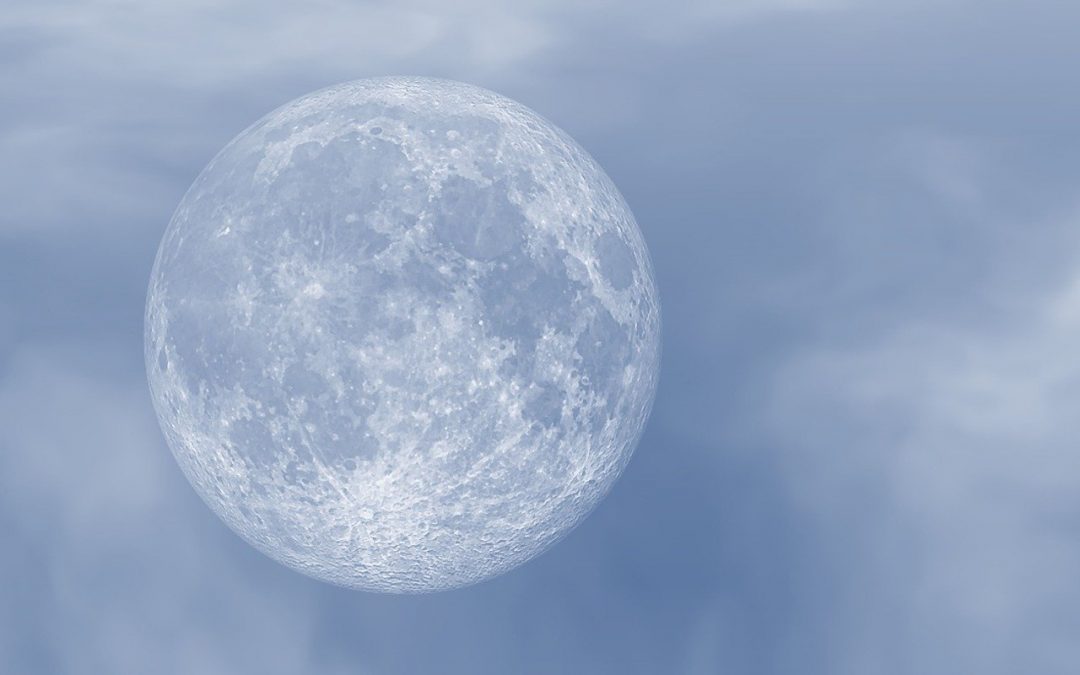
by Somya Devi | Oct 30, 2020 | Astrology, Conjunctions, Events, Planets Changing Signs, Retrograde
Full Moon and Election Astrology
This week’s full Moon reaches maximum opposition to the Sun at 10:49 am EDT on Saturday, October 31st, in sidereal Aries. The Moon will be full in Bharani nakshatra, “the bearer,” a Vedic star-sign that relates to both birth and death. The energy of the full Moon here creates a powerful portal between the realms of the living and non-living, a potent setup for both Halloween and the Mexican Day of the Dead celebrations.
Bharani Nakshatra
Bharani spans the middle of sidereal Aries, with the Full Moon at 14° this month. It is known as “the bearer” and is represented by the womb, but its deity is Yama, the Lord of death. People with planets here, especially the Moon, often work in fields relating to either birth or death. It is a creative nakshatra that allows us to birth visions into being, and also a powerful spiritual sign that allows us to let go and compost the old in order to rebirth it into something new.
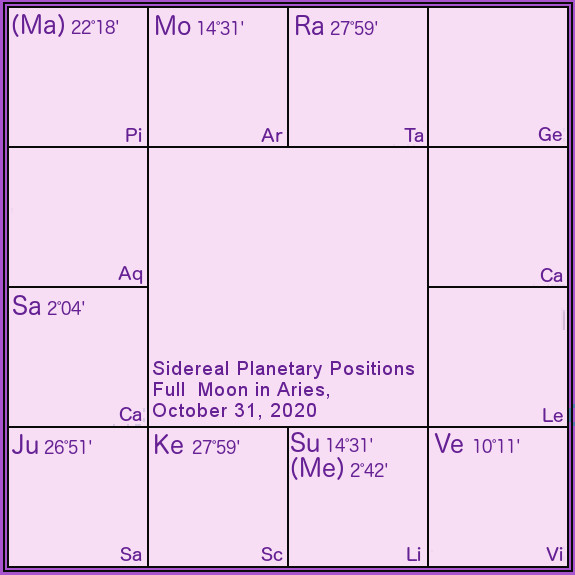
Aries Full Moon
The full Moon in Aries is opposite the debilitated Sun in sidereal Libra. Sun has been traveling through its sign of debilitation this month, which usually coincides with the onset of cold and flu season in the northern hemisphere, where 90% of humanity lives. The Sun relates with our vitality and strength, and when it is in Libra, a sign of balance and compromise, we may find that we become depleted as we attempt to create more harmony in the world around us and pay less attention to our personal strength. Self-care routines are most important during the Libra Sun cycle, which is running this year from October 16th through November 14th.
At the full Moon point of this cycle, the Moon becomes illuminated in Aries, the opposite of Libra. Ruled by Mars, Aries is a sign of personal strength, empowerment and action. It reminds us of our inner strength and gives us the opportunity to bring forth the light of individualism during the Sun cycle of Libra, a sign of partnership and compromising with others. The Aries full Moon time is a point of balance, where we learn to harmonize the desire to compromise with the ability to retain autonomy in a healthy way.
Mars and Mercury Retrograde
Both Mars and Mercury are still traveling in retrograde motion, through Pisces and Libra, respectively. Mercury will come to a station before beginning direct motion on November 3rd, election day. As the planet of the intellect, he will give us a sharp, discerning ability to make rational choices that are balancing. This bodes well for the U.S. election in terms of bringing more balance and practicality into the minds of voters in this polarized and radicalized democracy… though in the short-term, it could indicate an abundance of “balance” in terms of a close race in terms of numbers.
Astrological Presidential Potential
Joe Biden has at least as good a chance of Trump at being president, according to his astrology. A Scorpio rising with Sun in the first house, his tenth house is Leo, the house of career landing in the sign of government and kingship. His Rahu is also in the sign of Leo, indicating strong ambition in those arenas (and his career as a politician aligns with this natural tendency). Four of the last five presidents had either Leo rising (Trump, Obama, G.H.W. Bush), Rahu in Leo (Obama, G.H.W. Bush, as does Biden), Rahu in 10th (Trump, as does Biden) Sun in Leo (Clinton) or Sun in the 10th (G.H.W. Bush, Trump; Biden’s Sun rules the 10th). An association between Sun and Rahu with either the 10th, Leo, or the 1st are the common threads that we see in this group relating to the ability to take on the large governmental leadership role of President.
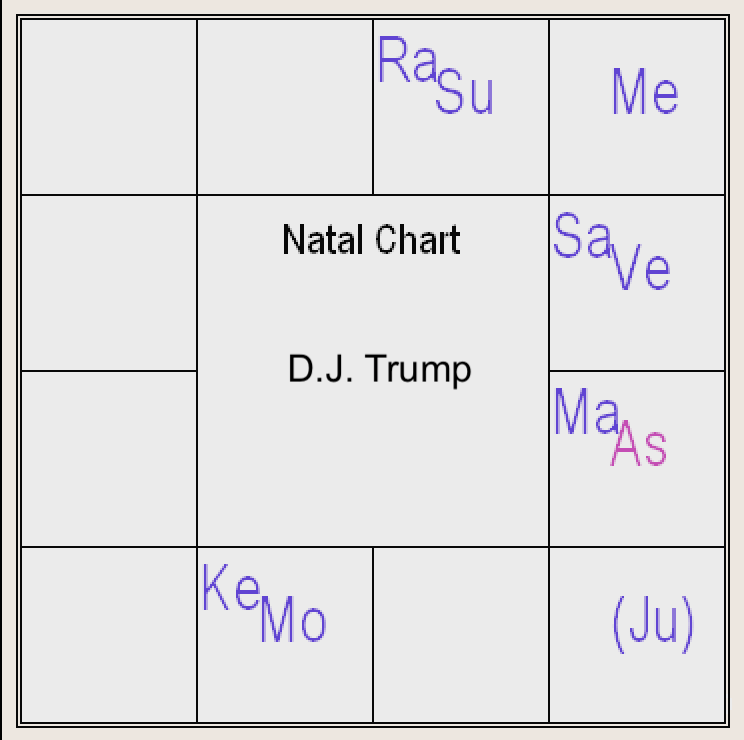
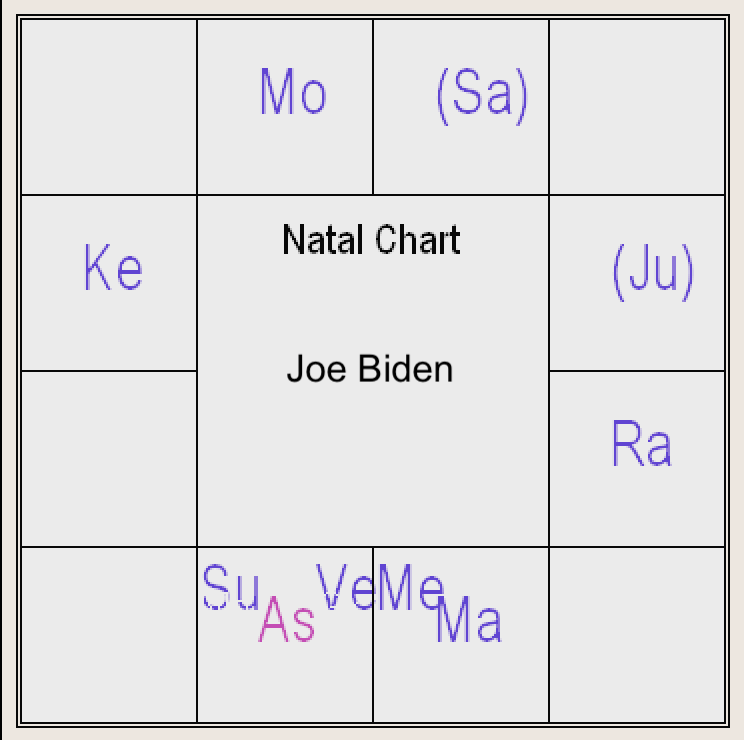 Of these men, only Trump has Rahu joining the Sun, which is also his lagna lord (ruling planet), bringing him fame while creating a kind of extremely intense personality that plays out in his professional life. Trump was elected just at the beginning of his Jupiter mahadasha (planetary period), a planet that indicates wealth in his chart and also activates some status elevation simultaneously. Trump also has a debilitated Moon afflicted by Ketu, and though full, creates many internal challenges to the mind.
Of these men, only Trump has Rahu joining the Sun, which is also his lagna lord (ruling planet), bringing him fame while creating a kind of extremely intense personality that plays out in his professional life. Trump was elected just at the beginning of his Jupiter mahadasha (planetary period), a planet that indicates wealth in his chart and also activates some status elevation simultaneously. Trump also has a debilitated Moon afflicted by Ketu, and though full, creates many internal challenges to the mind.
Biden is in his Jupiter>Rahu bhukti, the last phase of his Jupiter mahadasha. In his chart Jupiter is also a strong planet (stronger than Trump’s, with its dual exaltation and retrograde status), also positioned to indicate wealth and success. Rahu is in his 10th house, Leo, indicating a strong desire and ability to come into a position of leadership. As the last bhukti of one mahadasha, this phase a lead-up to his Saturn mahadasha that begins in 2022. Saturn is also a strong planet for Biden, with double natural strengths (positional and retrograde), opposite both its ruler Venus and the Sun.
To see how the current transits affect and interplay with your chart and karma, you can request a personal reading here.
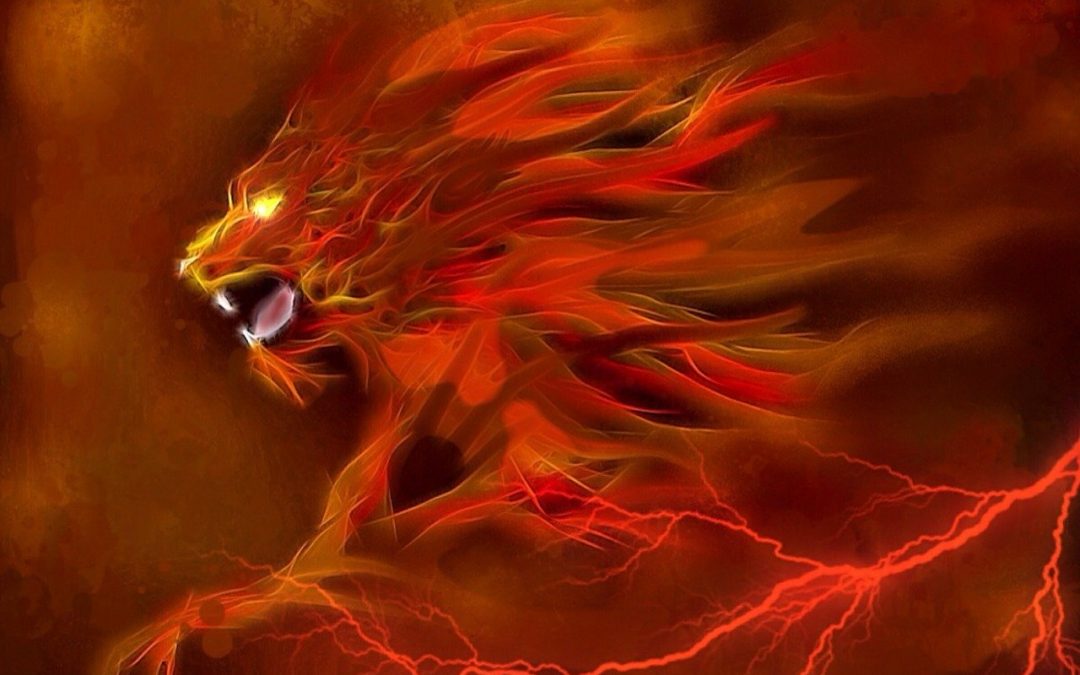
by Somya Devi | Aug 18, 2020 | Astrology, Conjunctions, Events, Planets Changing Signs, Retrograde
Tonight’s Dark Moon brings the Sun and Moon together in early sidereal Leo, at 7:42 pm PDT, close to Mercury, initiating a cycle of solar power where we are driven by the solar energy within as well as externally. This New Moon occurs within the Vedic sign of Magha, “the mighty,” bringing forth a regal energy that empowers us and begs the question of how to use our privilege and strength most effectively. Mars is also strengthening now, as he moves into his own sign of Aries for the next several months.
Leo Cycle
Leo is the sign ruled by the Sun, the literal source of power for all of us living in this solar system. The Leo cycle can help us to feel strong and inspired as we connect to source energy. When you’re feeling “in your power,” what do you then do with that energy? It’s a good time to check in with that especially as the northern summer draws towards an end. Take advantage of the light and all that you can do with the freedom that the long days offer. September 21st will bring the equinox wherein the days become shorter than the nights and the period of darkness rapidly descends.
Magha
Within Leo, Sun and Moon join to begin this lunar cycle in the Vedic nakshatra of Magha, “the mighty.” Symbolized by a throne, this star-sign brings forth a regal energy, gesturing towards achievement, status, and responsibility as well as privilege. It can be identified by the bright star Regulus within the constellation of Leo. Its deities are the Pitris, the ancestors of humanity, and indicates an important time to connect with our own ancestors and lineage. Ancestral karma could be at play in your life more than you realize, and this is a good time to pay attention to what is yours and what may be inherited.
Mars
Mars has also moved into his home sign of Aries now, and will transit here with great strength through October 3rd, when his retrograde journey (September 9th through November 13th) takes him back into Pisces again, before returning to Aries December 23rd through February 21st. With both fire planets, Mars and Sun, strong and in their home signs, we have the opportunity now to really harness and direct our creative energy. Be aware also, however, that your pitta could also be aggravated during this time, sending passions and irritability on a dangerous rampage if you are not using that fire for personal purification and strengthening. If you notice your pitta is getting out of hand, be sure to take in cooling activities, breaths, and foods…and avoid your hot yoga for a while.
Since the two fire planets gained strength by entering their own signs on August 16th, we have seen extreme heat waves and deadly wildfires sweeping the West. Watch out for these continuing through at least mid-September while the two are both strong.
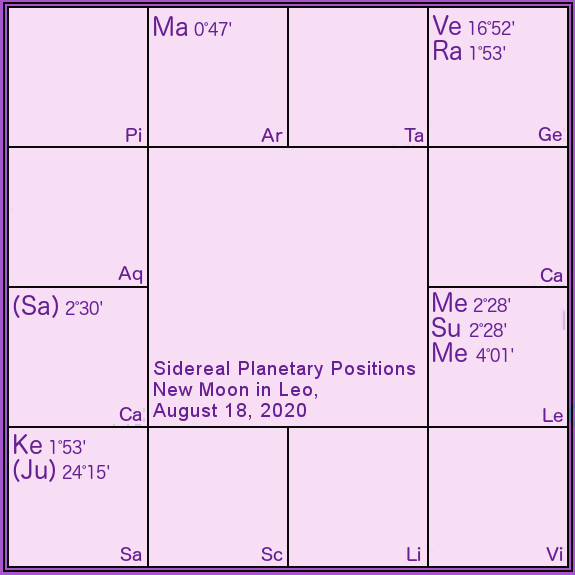
A Month for Social Movements
Both Mars and Sun are aspected by a strong and bright retrograde Jupiter, also in his own sign, which could augment their firepower. This aspect could also offer inspiration towards our actions this month, helping them to align with our belief systems. The strong and bright retrograde Saturn, also in his own sign, adds to these four to create a powerful royal yoga that will create many auspicious muhurta (times for taking specific actions) throughout the day.
With Mars and Aries on the ascendant (as it will be in the Eastern U.S. at this New Moon time, and in other locations throughout the day for the coming month), We find the first, fifth, 9th, 10th, 11th, and 12th lords all in their own sign. The houses of dharma as well as the houses relating to society and higher purpose are all strong from their lords’ sva nature at this time. With the interplay of Jupiter’s aspect as mentioned above, this could contribute to a lot of ideologically-motivated actions on both personal and societal levels. Remember that Saturn’s influence can be stern and discerning, however, so we will have to acknowledge and incorporate the responsibility and hard work that comes with the passionate actions that spring from our belief systems.
Ganesh Chaturthi
The celebration of Lord Ganesha, who is known as both the creator and destroyer of obstacles, is this Friday/Saturday depending on your location. May he clear the way to a more peaceful and harmonious planetary experience
Praying for positive change.
To see how these transits affect and interplay with your chart and karma, you can request a personal reading here.

by Somya Devi | Jan 23, 2020 | Astrology, Eclipses, Events, Planets Changing Signs, Retrograde
January 10th: Full Moon Lunar Eclipse in Gemini/Punarvasu
January 15th – September 23rd: Ketu in Mula
January 23, 2020 – April 28, 2022: Saturn in Capricorn
February 2nd – February 28th: Venus Exalted in Pisces
February 16th – March 9th: Mercury Retrograde
February 17th – July 15th: Kala Sarpa Cycles for half the month
March 22nd – May 4th: Mars in Exalted in Capricorn, with Saturn
March 28th – July 31st: Venus in Taurus
March 29th – June 29th: Jupiter in Capricorn
April 25th: Akshaya Tritiya
May 10th – September 28th: Saturn Retrograde
May 12th – June 24th: Venus Retrograde
May 14th – September 12th: Jupiter Retrograde
June 29th – November 18th: Jupiter back in Sagittarius
June 5th: Full Moon Lunar Eclipse in Scorpio/Jyestha
June 18th – August 16th: Mars in Pisces; again October 3rd – December 23rd
June 17th – July 12th: Mercury Retrograde
June 21st: New Moon Solar Eclipse in Gemini/Ardra
July 4th: Full Moon Lunar Eclipse in Sagittarius/Purva Ashada
August 16th – October 3rd: Mars in Aries
September 9th – November 13th: Mars Retrograde
September 12th: Jupiter Direct
September 23rd: Rahu & Ketu move into Taurus and Scorpio (Mean node; Sep. 19th with True)
September 28th: Saturn Direct
October 3rd – December 23rd: Mars in Pisces
October 13th – November 3rd: Mercury Retrograde
November 18th: Jupiter in Capricorn
November 30th: Full Moon Lunar Eclipse in Taurus/Rohini
December 14th: New Moon Total Solar Eclipse in Scorpio/Jyestha
Join my mailing list for free in-depth analysis as these events occur.
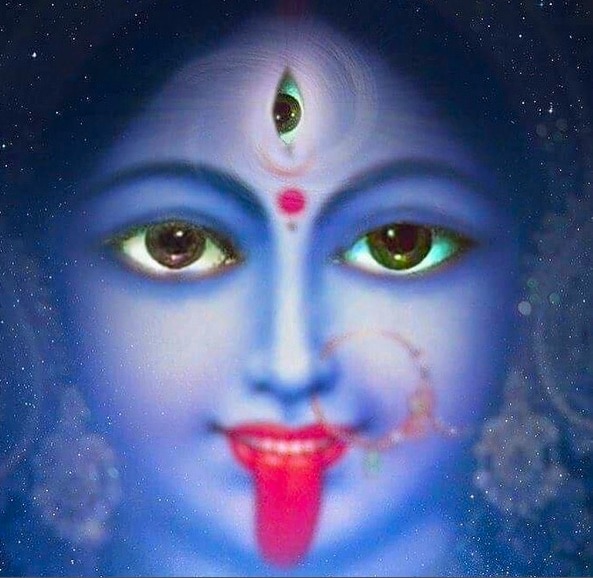
by Somya Devi | Sep 27, 2019 | Astrology, Events, Holy Days
Maha Navaratri 2019 is upon us! In this important Hindu holiday, we celebrate the Goddess through “the great nine nights” (nav = nine, ratri = night). This festival will run from September 29th through October 8th, the first ten days of this new lunar cycle. Goddess, Devi, Shakti, Durga, Divine Mother—the many names and forms all represent the dynamic and fluid feminine power that enlivens all of existence.
She is the creatrix, the warrioress, the nurturer, the purifyer, the protector. While she’s in the innocent and fertile maiden so is she the wise and learned crone. Both the nurturing mother, and the one who gives “tough love.” The impassioned lover, the devoted bhakta, the disciplined yogini. We see Goddess appear through us in innumerable manifestations. Through her many forms she teaches us and offers us countless blessings–love, compassion, courage, learning, discipline, surrender, success, enlightenment, and bliss. This festival is a time for celebrating the supreme feminine power in all her glory, and the many blessings she bestows upon us.
As with most Hindu celebrations, this festival correlates with the lunar calendar, and thus begins on the first day of the waxing Moon after the New Moon of September 28th. The celebration is through the “nine nights” of September 29th through October 7th, and into the tenth morning known as Vijayadashami, “the day of victory.” Worship during Navaratri is most generally dedicated to Goddess in the form of Durga, the demon-slayer, but there is much nuance and variation to practice and forms of celebration throughout India. Above all, Navaratri is a community celebration of the Divine Mother, and the love, abundance and protection she gives.
There are many Navaratri celebrations throughout the year, but the fall-time Navaratri is the most widely celebrated, and is thus called Maha Navaratri – “the great nine nights”. It correlates with the time of the harvest, a time to give thanks for the abundance of the year’s work. Grains and crops are often offered to Devi as part of the celebrations. Ritualistic worship (puja) typically occurs in homes and temples throughout the nine nights and into the tenth morning of celebration.
The Many Forms of Goddess
Durga-Lakshmi-Sarasvati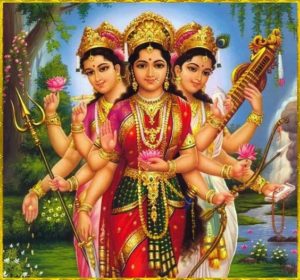
In Kerala and other places in India, the first three nights of worship are dedicated to Durga (the invincible), the next three to Lakshmi (Goddess of prosperity), and the final three to Sarasvati (Goddess of learning). Durga, also celebrated as her incarnation of Kali, helps us to destroy and remove the negative tendencies in our minds and hearts, freeing us from the obstructions to our spiritual and material pursuits. Lakshmi helps us to cultivate positive qualities like compassion and devotion, and leads us towards both spiritual and material prosperity. Sarasvati assists us in attaining knowledge and wisdom, through the illumination of our consciousness. She aids in awakening sattva, the quality of purity, and the flow of prana, the vital breath. After removing inner and outer obstacles and cultivating prosperity through virtuous qualities, our devotion, service, and practice help us to attain a state of peace, bliss, and oneness.
Sarasvati-Lakshmi-Kali/Durga
In the Kali Kula (Kali school of worship) in northeastern India, Sarasvati is worshiped on the first three nights, followed by Lakshmi on the next and then Kali/Durga on the last three. Sarasvati, Lakshmi, and Kali/Durga (Kali emerged from Durga) are also known as the consorts of Brahma, Vishnu, and Shiva. The Goddesses, therefore, provide the shakti to the cosmic processes of creation, preservation, and death (transformation), similar to their male counterparts. Consequently, worship in this manner is dedicated to the cycles of life and Mother nature, through birth, then sustenance, then death. Death is not a complete stop, but allows for the regeneration of energy into a new cycle once again.
9 Forms of Durga
Throughout India, the nine nights of Navaratri are often dedicated to 9 different incarnations of Durga, allowing the worship of many different aspects of Shakti in a gradual evolution. You can read the stories and significance of these 9 goddesses here, or a more a brief introduction, here:
“Daughter of the mountain”; creative energy, muladhara (root chakra), awakening; Awaken your connection with Goddess today or initiate a new venture, calling on Shailputri for new beginnings.
The ascetic; tapas, discipline, devotion, strength, wisdom, creative abundance; Good day for fasting and meditation, connection with svadhistana (sacral chakra).
Warrioress; protection, courage, grace, manipura (solar plexus); Destroy your internal obstacles by offering them to Chandraghanta.
Creatrix of the “cosmic egg”; strength, health, happiness, success, relationships; Connect with the vital Sun energy and the anahata (heart chakra) today.
“Mother of Skanda/Kartikeya”; motherly love, nourishment, protection, purity; Call on divine truth through the vishuddha (throat chakra), invoking Skandamata to lead you towards victory.
Warrioress who destroyed Mahishasura (the buffalo demon); victory, devotion, strength, removing obstacles; Meditate on these qualities of Goddess through the ajna chakra (third-eye) today.
“Dark/black night,” representing a fierce form of Durga/Kali; darkness, death, surrender, dissolution of pain; Connecting with the sahasrara (crown chakra), remember that Divine Mother offers love, compassion, and many blessings even in hard times. Even in the midst of apparent darkness, and helps us to go beyond the boundaries of the material body-mind and connect with spirit.
“Great white goddess”; detachment, purification, renewal, protection, virtue; Through detachment and devotion, we emerge purified, shining and radiant after surrendering in the dark night. Rejuvenative herbs and foods are good today.
Goddess of “siddhis”; magical, spiritual or mystic powers and blessings, fulfillment of desires, devotion, divine union; Invite Goddess to reveal her presence to you everywhere and in every moment.
Personal Practice Ideas for Navaratri
If possible, it is great to reduce our workload and gather with community at local temples or places of worship. We can also create a little time and space at home and conduct some personal practices to celebrate Goddess energy. Dive into your own heart to connect with the inner Goddess in the ways that resonate most with you! Here are some ideas to do at home or with a group throughout the nine nights of Navaratri:
Altar
Create a sacred space, a Durga altar, or a Goddess altar. Even if you already have one, you can refresh it in some way or rearrange it specifically for Navaratri. Include images or statues of the Goddess(es) you have a relationship with. This could be according to one of the groups of forms above.
Invocation
Even if you don’t have much time, dedicate at least a few minutes each day to connecting with the Divine Mother in front of your altar, calling her energy into your life and being.
Journal
Write in your journal about what qualities of Goddess you perceive and connect with. What aspects would you like to strengthen or to cultivate more deeply? Write any and all prayers and offer them to the form of Goddess that appeals to you.
Light
Offer light to illuminate Goddess’s power, helping her to shine more brightly into the world and your life. You can light a candle by the altar and keep it burning when you’re at home. You can even keep an electronic tealight on symbolically when you are away.
Flowers/Grains
Offer flowers or grains (even a small dish of dried rice) to celebrate Devi in the form of mother nature, fertility, the abundance of the harvest, and the cycle of life.
Offerings
Offer incense, bells, water, or food if you feel called, by placing it on the altar, or mentally offering it to Goddess throughout the day. You can also offer something symbolic of your own work or practice, whatever you have been cultivating for harvest through the year. In offering this you surrender the fruits of your efforts to the Divine Mother.
Fasting
Some people choose to fast in some variation, if this is something you have practiced before. This might include fasting during the day, fasting with only milk or fruit, or abstaining from alcohol and non-vegetarian foods during Navaratri.
Chanting
Chanting the Devi Mahatmyam, a verse to the Goddess, is a common practice during the nine-night festival. You can also chant another Goddess mantra or songs that are special to you and your relationship with Devi.
Jai Ma Durga!
Personal Vedic Astrology readings and forecasts are available Here.
Did you like Maha Navaratri 2019? Please Like, Comment and Share!
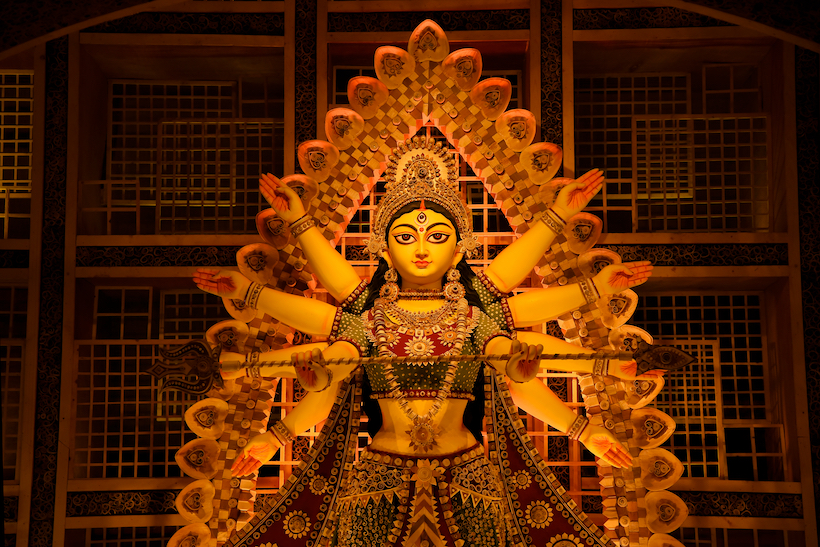
by Somya Devi | Sep 27, 2019 | Astrology, Conjunctions, Events, Holy Days, Planets Changing Signs
Tonight brings a dark Moon as the Moon joins the Sun in sidereal Virgo. Exact New Moon in Virgo will be at 11:26 am PT on Saturday, September 28th. This begins a Virgo cycle that will help us to connect with the earth, the feminine, and draw ourselves more inward as we enter the season of the Sun’s decent in the northern hemisphere.
Virgo Cycle
We’ve just passed the equinox on September 23rd, the time where night and day are of equal lengths, and we are now entering the yin season where the hours of darkness will exceed the hours of light. This first full lunar cycle begins in Virgo, a feminine earth sign, that encourages us to ground out some of the activity of summer and turn inwards as we come upon this darker season.
Virgo is also ruled by Mercury, the planet of the intellect, which will get us thinking about practicality and logistics this month. Have you planned your store for winter, getting together everything you need and tying up loose ends in the world before your period of inward attention and maybe even hybernation? Mercury is still technically joining the Sun and Moon in Virgo as we begin this cycle, but will be passing into Libra the next day. Venus and Mars also join in Virgo now, making our nights especially dark as these three stay close to the sun and only Jupiter and Saturn are visible. Venus remains debilitated in Virgo for just a few more days, until October 3rd.
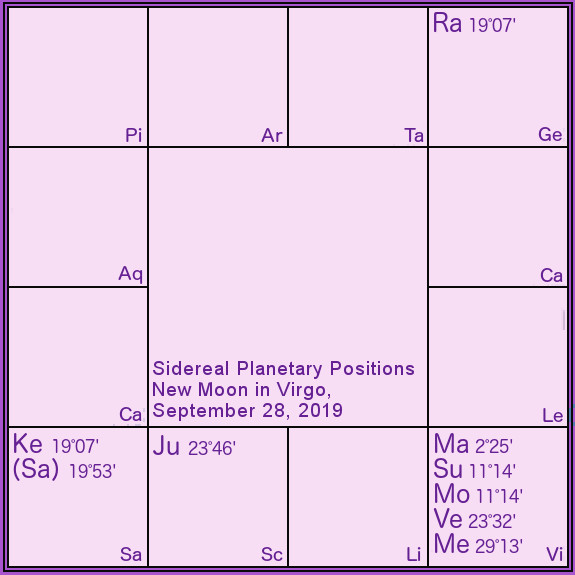
Hasta
This New Moon occurs with Sun and Moon in Hasta nakshatra, the sign of the hand. Hasta is a place that allows us to hone our skills, both manual and intellectual. It offers us a “craftiness,” whether literal, or of mind. This is a good time for getting into any hands-on work that requires dexterity, as well as for business dealings or other organization that requires tact and skill. Hasta is ruled by Savitar, the Sun God, while also linked to the Moon’s influence, and its animal is the female buffalo.
Maha Navaratri
The New Moon this month brings one of the largest Hindu festivals of the year, Maha Navaratri. Navaratri means “the nine nights,” and beginning with the first Moon phase after the dark Moon, the Goddess Devi is celebrated through many forms for the following nine nights and ten days. In North America Navaratri will be celebrated from September 29th through October 8th, with October 8th being the 10th day of Victory (an auspicious time for starting new endeavors, after 9 nights of worship). In some places Navaratri celebrates the goddess Durga in nine of her forms, while in other parts of India the festival commemorates Durga/Kali, Lakshmi, and Sarasvati for three nights each.
Devi is the creatrix, the warrioress, the nurturer, the purifyer, the protector. She can be found in the innocent and fertile maiden as well as the wise and learned crone. She is both the nurturing mother, and the one who gives “tough love.” The impassioned lover, the devoted bhakta, the disciplined yogini. We see Devi appear through us in innumerable manifestations. Through her many forms, she teaches us and offers us countless blessings–love, compassion, courage, learning, discipline, surrender, success, enlightenment, and bliss.
This festival is a time for honoring and celebrating the supreme feminine power in all her glory, and the many blessings she bestows upon us. Read more about Maha Navaratri 2019 here, and stay tuned for daily updates on how to connect with the many forms of the Goddess.
Kala Sarpa & Nodal Influences
This year’s festival could churn up even more internal difficulties than usual … offer them to the Goddess! We are currently under a Kala Sarpa cycle, with all planets to one side of the Rahu-Ketu axis, and will be in this alignment until October 6th. This can bring up more shadow energy and sticky spots than usual, especially if you are running a Rahu-Ketu dasha or have these planets prominently in your chart. It’s all the more reason to join the festivities and offer worship or some kind of spiritual practice during these days.
The good news on the nodal front — Saturn and Ketu will finally be separating a bit, and will leave their 1-degree proximity on October 1st! With Mean Node calculations, Ketu and Saturn have been joined within one degree of each other since April 25th! This will begin to slowly take some pressure off in the area of your life shown by Sagittarius, or those ruled by Saturn.












